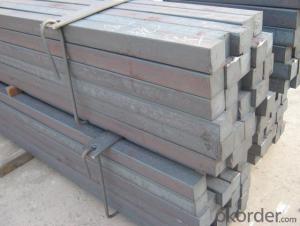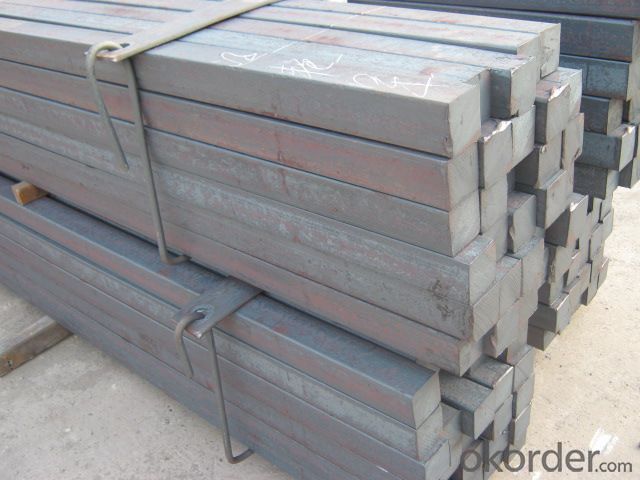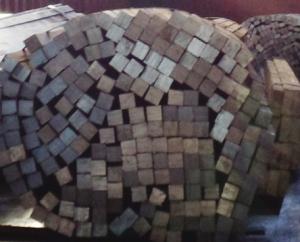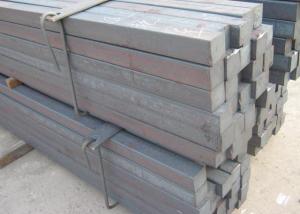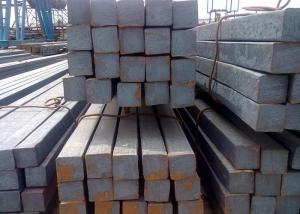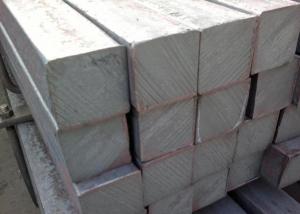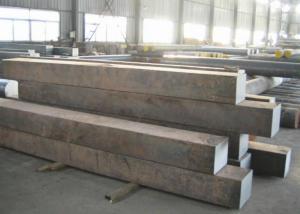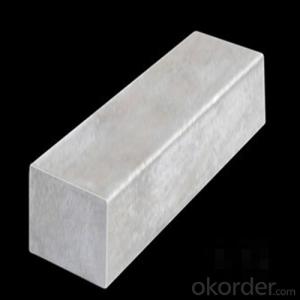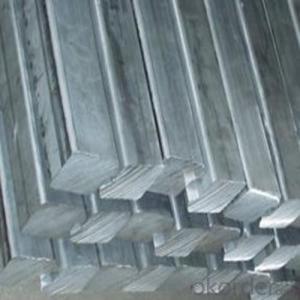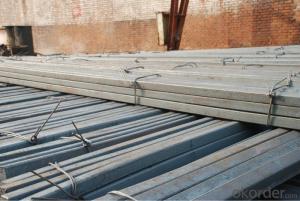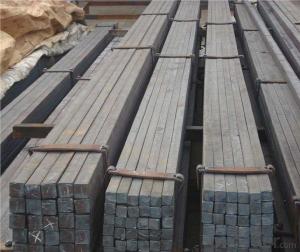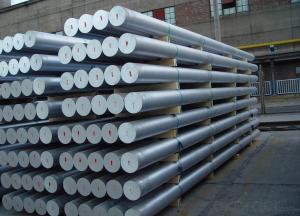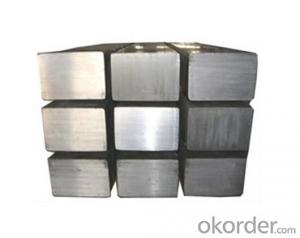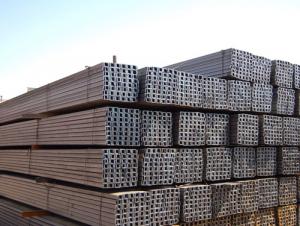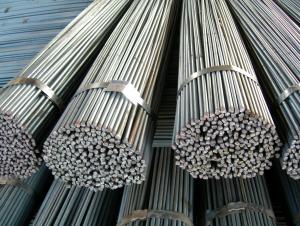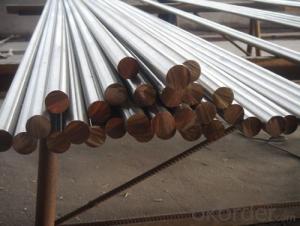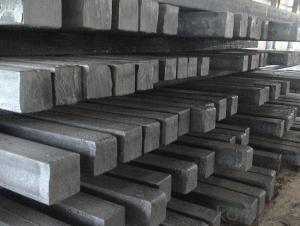Steel Square Bar 5mm-100mm Q195 or Q235 top quality
- Loading Port:
- China main port
- Payment Terms:
- TT OR LC
- Min Order Qty:
- 50 m.t.
- Supply Capability:
- 10000 m.t./month
OKorder Service Pledge
OKorder Financial Service
You Might Also Like
Steel Square Bar High Quality 5mm-100mm Q195 or Q235
Product Description:
OKorder is offering High Quality Square Bar 5mm-100mm Q195 or Q235 at great prices with worldwide shipping. Our supplier is a world-class manufacturer of steel, with our products utilized the world over. OKorder annually supplies products to European, North American and Asian markets. We provide quotations within 24 hours of receiving an inquiry and guarantee competitive prices.
Product Applications:
1) Suitable for making various strong cutting tool abrasion resistance, impact resistance.
2) Used to produce all kinds of high hard and super hard saw blade, drill, tap, broach, gear hob and various kinds of milling cutter.
3) Used for advanced punching die, screw die, and the toughness and complicated shape of the punch, etc.
4) Is used for cold forging die and drawing mode, etc.
5) Recommended watchcase factory, screw factory and other cold stamping products industry use.
Product Advantages:
OKorder's High Quality Square Bar 5mm-100mm Q195 or Q235 are durable, strong, and resist corrosion.
Main Product Features:
· Premium quality
· Prompt delivery & seaworthy packing (30 days after receiving deposit)
· Corrosion resistance
· Can be recycled and reused
· Mill test certification
· Professional Service
· Competitive pricing
Product Specifications:
Standard: GB,
-Grade: Q195 or equivalent.
-Chemical Composition:
Standard | Grade | Element (%) | ||||
GB | Q195 | C | Mn | S | P | Si |
0.06~0.12 | 0.25~0.50 | ≤0.050 | ≤0.045 | ≤0.30 | ||
Measures of HR Square Bar (small measures):
-Length of a side and Theoretical weight of Square Bar.
Length of a side(mm) | Theoretical weight(kg/m) | Length of a side(mm) | Theoretical weight(kg/m) |
7 | 0.385 | 22 | 3.80 |
8 | 0.502 | 24 | 4.52 |
9 | 0.636 | 25 | 4.91 |
10 | 0.785 | 26 | 5.30 |
11 | 0.950 | 28 | 6.15 |
12 | 1.13 | 30 | 7.06 |
13 | 1.33 | 32 | 8.04 |
14 | 1.54 | 34 | 9.07 |
15 | 1.77 | 36 | 10.17 |
16 | 2.01 | 38 | 11.24 |
17 | 2.27 | 40 | 12.56 |
18 | 2.54 | 42 | 13.85 |
19 | 2.82 | 45 | 15.90 |
20 | 3.14 | 48 | 18.09 |
21 | 3.46 | 50 | 19.63 |
Notes:
1, The theoretical weights in the list, base on the density of 7.85 g/cm3.
2, Formula for theoretical weight of Square bar: (length of a side)2 * 0.00785
3, The numbers with *mean that they are not regular or we don’t offer them.
-Regular length of Square Bar:
Steel | Length of a side (mm) | Length of steel (m) |
Normal steel | < 25 | 4~10 |
> 25 | 3~9 | |
Steel of high quality | All measure | 2~6 |
Tool steel >75 | 1~6 |
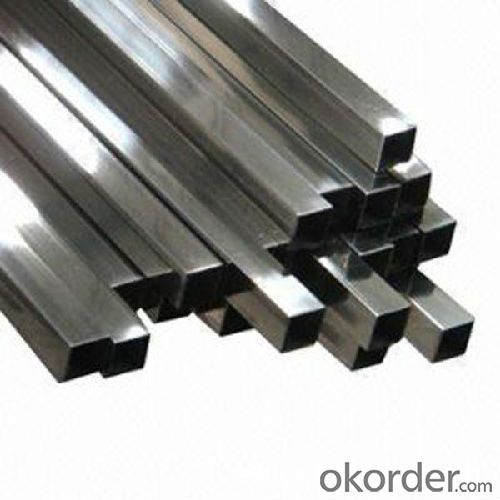
- Q: What are the different ways to read angles on a steel square?
- There are typically three different ways to read angles on a steel square: 1. Degree scale: Steel squares often have a degree scale on one of the arms, allowing you to directly read the angle in degrees. This scale is useful for precise measurements and accurate angle readings. 2. Protractor scale: Some steel squares feature a protractor scale, which allows you to measure angles more precisely. By aligning the square's edge with the angle you want to measure, you can read the angle directly from the protractor scale. 3. Vernier scale: Certain steel squares may also have a vernier scale, which provides a more detailed measurement of angles. By aligning the square's edge with the angle you want to measure, you can read the angle from the vernier scale and get a more precise reading than with a regular degree scale.
- Q: What are the uses of a steel square in construction?
- A steel square, also known as a framing square or carpenter's square, is a versatile tool widely used in construction for various purposes. Some of the key uses of a steel square in construction are: 1. Measuring and marking: A steel square is primarily used for measuring and marking straight lines and angles accurately. It consists of two arms, one long and one shorter, forming a right angle. This allows for precise measurements and marking of 90-degree angles, ensuring straight and square cuts. 2. Layout and framing: Steel squares are essential for layout work in construction projects. They help carpenters and builders lay out and mark building components, such as walls, roofs, stairs, and door frames, ensuring proper alignment and dimensions. The square's edges and measurements allow for precise layout and framing, resulting in well-built structures. 3. Cutting and sawing: Steel squares are often used as a guide for cutting and sawing materials. By aligning the square with the edge of the material, it provides a straight and accurate reference line for cutting with a saw or other tools. This helps prevent errors and ensures clean and precise cuts, especially for tasks like cross-cutting or mitering. 4. Checking and testing: Steel squares are useful for checking and testing the accuracy and squareness of existing structures or finished components. By comparing the square's edges against existing angles or corners, builders can identify any discrepancies or misalignment that need correction. This helps maintain the structural integrity and overall quality of construction projects. 5. Plumbing and leveling: In addition to measuring angles, steel squares can also be used for plumbing and leveling tasks. For example, when installing cabinets or shelves, a square can be used to ensure the vertical alignment of the components. It can also be used to check the levelness of surfaces, such as countertops or floors, by comparing the square's edges to the surface. Overall, a steel square is an essential tool in construction due to its versatility and accuracy. Its uses range from measuring and marking to layout, cutting, checking, and leveling, making it indispensable for builders, carpenters, and other construction professionals.
- Q: What is the difference between a framing square and a try square?
- Woodworking and construction employ both framing squares and try squares, but these tools differ in their design and purpose. The framing square, also referred to as a carpenter's square or steel square, is a more sizable and adaptable tool. Typically, it possesses a longer blade, approximately 24 inches, and a shorter tongue or handle, around 16 inches. At a 90-degree angle, the blade and tongue converge, forming the shape of an L. This configuration enables the framing square to undertake various tasks, including laying out and marking right angles, verifying the squareness of structures, measuring angles, and performing intricate calculations for carpentry and framing projects. On the other hand, the try square represents a smaller and more compact implement. Comprising a concise blade, typically ranging from 6 to 12 inches, and a shorter handle, typically measuring 3 to 6 inches, the try square also creates an L shape when the blade and handle intersect at a 90-degree angle, much like the framing square does. However, the primary function of the try square revolves around examining and marking right angles, guaranteeing the accuracy and squareness of joints, and conducting precise measurements in woodworking endeavors. This includes marking and cutting 90-degree angles on boards and confirming the squareness of edges and corners. In conclusion, the disparity between a framing square and a try square lies in their dimensions, versatility, and intended application. The framing square, being larger and more versatile, accommodates a broad spectrum of tasks in carpentry and construction. Comparatively, the try square, smaller and compact, concentrates on verifying and marking right angles in woodworking projects.
- Q: Can a steel square be used for gazebo roofing?
- Yes, a steel square can be used for gazebo roofing. Steel squares are commonly used in construction for their strength and durability. They provide a sturdy base for roofing materials and can withstand various weather conditions. However, it is important to ensure that the steel square is properly installed and secured to the gazebo structure to ensure a safe and long-lasting roofing solution. Additionally, it is recommended to consult with a professional or follow the manufacturer's guidelines to ensure the steel square is suitable for the specific gazebo design and weight requirements.
- Q: How do you use a steel square to measure and mark parallel lines?
- To use a steel square to measure and mark parallel lines, you need to align one edge of the square with the starting point of the line. Then, hold the square firmly in place and draw a line along the other edge of the square. Repeat this process at the desired interval to create parallel lines.
- Q: What is the purpose of the lip or flange on a steel square?
- The lip or flange on a steel square serves the purpose of providing a reference edge for marking lines or making precise measurements. Typically positioned perpendicular to the body of the square, it allows for alignment with the workpiece's edge. By sliding the lip along the material's edge, it ensures proper alignment of the square and enables accurate marking or measuring. This useful feature finds particular application in woodworking, metalworking, and other trades that require precision. Moreover, the lip or flange can also function as a stop or guide for repetitive cuts or layouts, further enhancing its usefulness. Overall, the steel square's lip or flange enhances precision and efficiency in various industries by improving the accuracy of different tasks.
- Q: How do you use a steel square to measure the height of a window frame?
- In order to measure the height of a window frame using a steel square, the following steps should be followed: 1. Begin by positioning the steel square vertically against one side of the window frame, ensuring its alignment with the wall and parallelism with the ground. 2. Adjust the position of the square vertically until its edge aligns with the top of the window frame, while still maintaining its flushness against the wall. 3. Once the square is aligned with the top of the window frame, firmly hold it in place. 4. Consult the scale on the steel square to determine the measurement. Ensure that you are using the appropriate unit of measurement, as the scale is typically marked in inches or centimeters. 5. Take note of the measurement where the top edge of the window frame aligns with the scale on the steel square. This will provide you with the height of the window frame. It is important to remember to take accurate measurements and repeat the process on the opposite side of the window frame for consistency verification. Additionally, measuring multiple times is always recommended to ensure precision.
- Q: How do you use a steel square to lay out a parallelogram?
- To use a steel square to lay out a parallelogram, you would start by marking a straight line using the long edge of the steel square. Then, you would use the shorter edge of the square to mark two perpendicular lines from the ends of the straight line. Finally, connect the ends of the perpendicular lines to complete the parallelogram shape.
- Q: Can a steel square be used for framing a wall?
- Yes, a steel square can be used for framing a wall. Steel squares are commonly used in construction for measuring and marking angles, as well as for laying out and checking the accuracy of cuts. They provide a sturdy and reliable tool for ensuring precise and straight cuts when framing walls.
- Q: Can a steel square be used for measuring pipe fittings?
- Yes, a steel square can be used for measuring pipe fittings. The straight edges of a steel square can be used to ensure that the pipe fittings are at right angles to each other. Additionally, the 90-degree angle of the square can be used to verify the accuracy of the pipe fitting's angles and ensure that they are properly aligned. However, it is important to note that for precise measurements and to account for any variations in the thickness of the pipe or fitting, specialized measuring tools such as calipers or tape measures may be more appropriate.
Send your message to us
Steel Square Bar 5mm-100mm Q195 or Q235 top quality
- Loading Port:
- China main port
- Payment Terms:
- TT OR LC
- Min Order Qty:
- 50 m.t.
- Supply Capability:
- 10000 m.t./month
OKorder Service Pledge
OKorder Financial Service
Similar products
Hot products
Hot Searches
Related keywords
